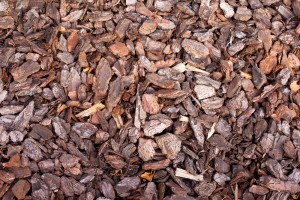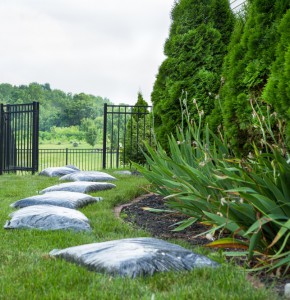
What’s Your Mulch I.Q.?
Why Mulch?
In my previous blog post I talked about fall lawn care activities including fertilizing, applying pre-emergent herbicides and overseeding. Another “to do” in the fall is mulching. You’ll find a lot of conflicting information about mulches, as well as conflicting opinions on which mulches are best, on the Internet. The reality is that there is no real definitive answer to the question of which mulch is best. Mulch choices vary  by areas of the United States and goals and preferences of homeowners. If the question is simply to mulch or not to much, however, the answer is simple: mulch. While mulching can add to the attractiveness of your landscape, there are many functional and more important reasons to add organic mulch your landscape beds and gardens.
by areas of the United States and goals and preferences of homeowners. If the question is simply to mulch or not to much, however, the answer is simple: mulch. While mulching can add to the attractiveness of your landscape, there are many functional and more important reasons to add organic mulch your landscape beds and gardens.
Although Dallas enjoys a moderate winter season, the nights are colder and freezing temperatures are not uncommon. Mulch acts as an insulator, regulating soil temperatures and lessening the effects of fluctuating temperatures on plant roots. Mulch helps the soil retain moisture, suppresses weed growth, and deters erosion and damage from wind and leaf blowers. Plants establish deep roots and grow healthier with proper mulch than without it. Additionally, when good quality organic mulches are used, they release valuable nutrients into the soil as they decompose, (although they are not a substitute for fertilizers).
It is important to remember not to place mulch directly against plant stems or tree bases as this may cause them to retain excess moisture which will cause them to rot.
Hardwood Bark Mulch
Made of shredded bark from hardwood trees such as oaks and maples, hardwood bark is a byproduct of the debarking process of hardwood trees as they are processed into lumber and paper pulp. The bark is then double ground and aged. High-quality bark  mulches are also screened to remove small particles (less than 3/8”) to mitigate the potential of tying up nitrogen by mixing into the soil bed. (Wood is carbon; carbon always looks for nitrogen to bond with so it can breakdown into new soil—that’s the principle behind composting. Bigger particles help ensure that the organic matter that is applied on top of the soil stays on top and only interacts with surface soil so that it does not affect nitrogen levels down in the bed.) Hardwood bark mulch is sturdy and compacts over time so it resists blowing or washing away. Mulch color ranges from medium to deep brown. At Bonick Landscaping we prefer to use high-quality hardwood bark mulch, made from local oak trees.
mulches are also screened to remove small particles (less than 3/8”) to mitigate the potential of tying up nitrogen by mixing into the soil bed. (Wood is carbon; carbon always looks for nitrogen to bond with so it can breakdown into new soil—that’s the principle behind composting. Bigger particles help ensure that the organic matter that is applied on top of the soil stays on top and only interacts with surface soil so that it does not affect nitrogen levels down in the bed.) Hardwood bark mulch is sturdy and compacts over time so it resists blowing or washing away. Mulch color ranges from medium to deep brown. At Bonick Landscaping we prefer to use high-quality hardwood bark mulch, made from local oak trees.
Hardwood Mulch Mixes
It is important to recognize the difference between 100% tree bark mulch and other hardwood mulches that either contain a mix or no bark at all. Some people are attracted to these mulches because they are dyed, usually black or red. Dye can cover up inferior materials such as pulverized wood from pallets and other wood products from demolitions. The wood in these products may have been treated with chemicals, such as preservatives, and termite treatments that can leach into the soil. Additionally, pallet wood has an extremely high carbon-to-nitrogen ratio, so if it does get ground into the soil, it’s going to steal more nitrogen from needy plants. Obviously, we recommend steering clear of these mulch mixes.
Other Organic Mulch Choices
Cedar mulch comes from the bark of cedar trees and can be shredded or chipped. Many people like it because of the smell and the fact that it deters some insect pests. It is important to remember, however, that cedar mulch may discourage beneficial insects from entering your garden as well. Although cedar mulch breaks down and is organic, it takes longer to break down than other bark mulches. Because of this, cedar isn’t as effective in returning nutrients to the soil as some other forms of mulch.
Pine bark mulch and pine needles add acidity to soil as they break down, so they are a good choice for plants that thrive an acidic soils such as azaleas, gardenias, begonias, and caladiums. Pine bark is lightweight and floats easily so it is not a good choice where water pools or where moving water can wash it away. Pine bark mulch also has a higher carbon-to-nitrogen ratio than most other bark mulches. Like pine bark, pine needles are best used around plants that like acidic soil. While some people like the look of pine needles, some find them unattractive as they age and turn silver-grey. Additionally, pine needles look out of place in yards that don’t have pine trees.
 There is a lot of controversy surrounding cypress mulch. Some people like its distinctive aroma and the fact that it retains its color. However, most cypress mulch today is made from immature cypress trees that have not yet developed the rot- and insect-repellent qualities of older cypress that some value. The controversy comes in with regard to its sustainability. The Soil and Mulch Council claims that “Currently in Louisiana, cypress forests are growing six times faster than trees are being harvested with 400,000 new cypress trees planted each year and even more naturally regenerated. Cypress trees are not being cut in areas such as flooded swamps where they will not regrow.” However, many other sources claim cypress is not sustainable. These sources argue that cypress trees take about 100 years to mature, and that over-harvesting without reforestation has had a drastic impact on wetland habitats, forcing many animal species to relocate. According to the University of Florida, cypress trees are an essential component of Florida and Louisiana wetlands, where they serve as an integral part of the wetland ecosystem. The roots of cypress trees filter water and low-lying cypress forests are reservoirs for floodwaters. Because of the questions regarding sustainability, as well as the other “cons” mentioned, we do not recommend the use of cypress mulch.
There is a lot of controversy surrounding cypress mulch. Some people like its distinctive aroma and the fact that it retains its color. However, most cypress mulch today is made from immature cypress trees that have not yet developed the rot- and insect-repellent qualities of older cypress that some value. The controversy comes in with regard to its sustainability. The Soil and Mulch Council claims that “Currently in Louisiana, cypress forests are growing six times faster than trees are being harvested with 400,000 new cypress trees planted each year and even more naturally regenerated. Cypress trees are not being cut in areas such as flooded swamps where they will not regrow.” However, many other sources claim cypress is not sustainable. These sources argue that cypress trees take about 100 years to mature, and that over-harvesting without reforestation has had a drastic impact on wetland habitats, forcing many animal species to relocate. According to the University of Florida, cypress trees are an essential component of Florida and Louisiana wetlands, where they serve as an integral part of the wetland ecosystem. The roots of cypress trees filter water and low-lying cypress forests are reservoirs for floodwaters. Because of the questions regarding sustainability, as well as the other “cons” mentioned, we do not recommend the use of cypress mulch.
Does Hardwood Bark Mulch Attract Termites?
This is a common misconception. The reality is that termites are subterranean and live in moist environments. Any kind of mulch helps soil retain moisture so when you dig underneath it you’re likely to find all kinds of insects. These insects are already in your soil and wander into the mulch in your planting beds, like it, and decide to stay. But it is not the scenario many people envision where you put down mulch and somehow termites “know” it’s there and make a beeline for it! Mulch doesn’t attract termites or cause termites to multiply, and termites do not feed on bark mulch. Termites prefer the white wood of the inner tree. All this said, pest control companies do advise against piling mulch against the side of your house since it can increase the chances of termites entering your home.
For over 30 years, Bonick Landscaping, has served Dallas area clients with the highest standards looking for out-of-the-ordinary luxury landscape design and pools by offering the best in service, workmanship, and plantings. Services include hardscape and landscape design, pool designs, pool construction and installation, estate management, lawn care services and garden maintenance, pool maintenance, and more. For discerning clients in Dallas who want to express their own distinctive style through their landscaping, Bonick Landscaping can help you realize your dream. Call us at 972-243-9673 or visit our website at www.bonicklandscaping.com.